annie besant
︎Painting, Philosophy, Spirituality,
︎ Ventral Is Golden
annie besant
︎Painting, Philosophy, Spirituality,
︎ Ventral Is Golden
︎ Ventral Is Golden
“A myth is far truer than a history, for a history only gives a story of the shadows, whereas myth gives a story of the substances that cast the shadows.”
 ︎Thought Form - Annie Besant & C.W Leadbeater, 1901
︎Thought Form - Annie Besant & C.W Leadbeater, 1901Annie Besant (rhymes with pleasant) lived between 1 October 1847 – 20 September 1933. She was a British Socialist, Theosophist, Women's Rights Activist, writer and public speaker, who became a powerful influence in the spiritual revival of eastern religions and philosophy in both the east and west from the early 1900’s.
As a young wife of a clergyman, Besant quickly became angered by the provincial worldview of Christianity. For Besant, the Christianity of her time represented a fundamental hypocrisy, where people would worship the suffering of their saviour, but did nothing to alleviate the poverty-stricken working classes of their communities. After refusing to take her Holy Communion in her husand’s church, she was offered an ultimatum - to participate or leave. She stated in her autobiography, “between hipocracy or expulsion, I chose the latter”, and promptly left her village in Lincolnshire and moved with her two children to London.
Whilst in London she would later become a gifted public speaker and social activist, supporting Irish and Indian self-rule, campaigning tirelessly in her early career as an editor for the National Secular Society, on social issues ranging from women's working rights to freedom of speech. She was also engaged in an obsenity trial for daring to publish information about birth control, which subsequently led to her losing custody over her children, as her former husband claimed her ideas made her unfit to be their mother. After experiencing such profound grief over these court cases, Besant was even more determined to expose the deeply embedded negative social attitudes surrounding the freedom of thinking.
For Besant, politics, education, friendship and love were always closely intertwined, but it wasn’t until 1889, after receiving a book to review for the Pall Mall Gazette, that she became once again absorbed by profound spiritual insights, this time not through the dogmas of the church, but detailed by the author HP Blavatsky - a Russian mystic, Mother of the New Age, and founder of the Theosophical movement.
Disenchanted by western social attitudes and full of intellectual receptivity to these new ideas, Besant’s philosophical views became infused with the spiritually derived, humanitarian ethos of ‘The Secret Doctrine’ (the Synthesis of Science, Religion and Philosophy). After reading The Secret Doctrine, Besant sought an interview with the mysterious Blavatsky and eventually set up a meeting at her home in Paris, after which Besant abandoned her secularist ideas and adopted an approach to comprehending the root casues of the unseen habits which govern social existence.
Both Blavatsky’s literature and the Theosophical society were for Besant a culmination of her life’s work and an attempt to understand the transcendental cause of human suffering.
By 1893, following the death of Blavatsky, Besant became the president of the Theosophical Society and endeavoured to make it’s principles a practical force for shaping future societies. Her work with the Theosophists in India led to many reforms, including the creation of the Central Hindu Girls School and the establishment of the Indian Home Rule Movement.
During the time of the British occupation of India, when so many westerners were looking towards the east for spiritual inspiration, the majority of Indians were being sent to Britain to learn the ways of their imperial rulers. Besant became a hugely influential figure in the Hindu renaissance movement that underpinned a lot of the Theosophical teachings. She would infuse her spiritual beliefs with her divine sense of social justice by being elected as the first female president of the Indian National Congress - transforming the group from a gentlemen’s club into a dominant force for social change. It represented the sovereign rights of the Indian working classes and strongly encouraged female participation in public reformation, whilst preserving the spiritual temperament of the feminine - which Besant viewed as being perfected within the Indian woman.
The mantle of her political work in India would later be taken up by a young Indian law student, Mahatma Gandhi, who arrived in London at eighteen years old, eventually meeting Besant, Blavatsky and other radical thinkers who exposed him to their critical views of Victorian society and contextualised their political ideas within the framework of the kinds of esotericism that they derived from the compassionate source of Hindu and Buddhist teachings.
As a young wife of a clergyman, Besant quickly became angered by the provincial worldview of Christianity. For Besant, the Christianity of her time represented a fundamental hypocrisy, where people would worship the suffering of their saviour, but did nothing to alleviate the poverty-stricken working classes of their communities. After refusing to take her Holy Communion in her husand’s church, she was offered an ultimatum - to participate or leave. She stated in her autobiography, “between hipocracy or expulsion, I chose the latter”, and promptly left her village in Lincolnshire and moved with her two children to London.
Whilst in London she would later become a gifted public speaker and social activist, supporting Irish and Indian self-rule, campaigning tirelessly in her early career as an editor for the National Secular Society, on social issues ranging from women's working rights to freedom of speech. She was also engaged in an obsenity trial for daring to publish information about birth control, which subsequently led to her losing custody over her children, as her former husband claimed her ideas made her unfit to be their mother. After experiencing such profound grief over these court cases, Besant was even more determined to expose the deeply embedded negative social attitudes surrounding the freedom of thinking.
For Besant, politics, education, friendship and love were always closely intertwined, but it wasn’t until 1889, after receiving a book to review for the Pall Mall Gazette, that she became once again absorbed by profound spiritual insights, this time not through the dogmas of the church, but detailed by the author HP Blavatsky - a Russian mystic, Mother of the New Age, and founder of the Theosophical movement.
Disenchanted by western social attitudes and full of intellectual receptivity to these new ideas, Besant’s philosophical views became infused with the spiritually derived, humanitarian ethos of ‘The Secret Doctrine’ (the Synthesis of Science, Religion and Philosophy). After reading The Secret Doctrine, Besant sought an interview with the mysterious Blavatsky and eventually set up a meeting at her home in Paris, after which Besant abandoned her secularist ideas and adopted an approach to comprehending the root casues of the unseen habits which govern social existence.
Both Blavatsky’s literature and the Theosophical society were for Besant a culmination of her life’s work and an attempt to understand the transcendental cause of human suffering.
By 1893, following the death of Blavatsky, Besant became the president of the Theosophical Society and endeavoured to make it’s principles a practical force for shaping future societies. Her work with the Theosophists in India led to many reforms, including the creation of the Central Hindu Girls School and the establishment of the Indian Home Rule Movement.
During the time of the British occupation of India, when so many westerners were looking towards the east for spiritual inspiration, the majority of Indians were being sent to Britain to learn the ways of their imperial rulers. Besant became a hugely influential figure in the Hindu renaissance movement that underpinned a lot of the Theosophical teachings. She would infuse her spiritual beliefs with her divine sense of social justice by being elected as the first female president of the Indian National Congress - transforming the group from a gentlemen’s club into a dominant force for social change. It represented the sovereign rights of the Indian working classes and strongly encouraged female participation in public reformation, whilst preserving the spiritual temperament of the feminine - which Besant viewed as being perfected within the Indian woman.
The mantle of her political work in India would later be taken up by a young Indian law student, Mahatma Gandhi, who arrived in London at eighteen years old, eventually meeting Besant, Blavatsky and other radical thinkers who exposed him to their critical views of Victorian society and contextualised their political ideas within the framework of the kinds of esotericism that they derived from the compassionate source of Hindu and Buddhist teachings.


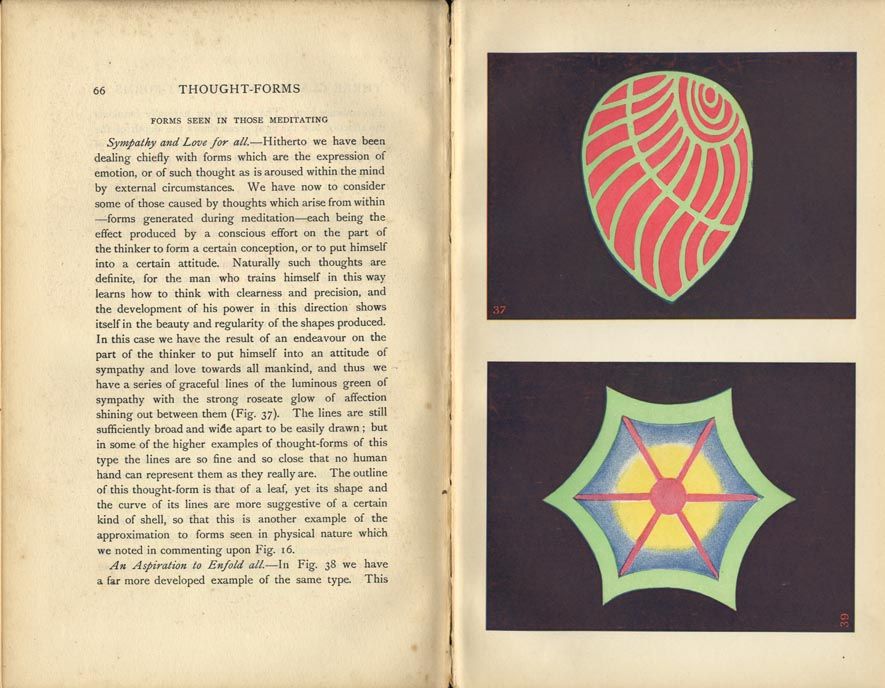
Not only was Besant making huge cultural and political contributions with her social and spiritual reforms in England and the far east, her collaborative works with occultist and fellow Theosophist, C. W. Leadbeater would greatly influence art theory across central Europe. Their collaborative book, Thought-Forms, published in 1905, was a means of cataloguing the non-figurative forms that occupied the inner world of sensory archetypes. Entities of the imaginal realm, visible and vibrating states of what remains generally invisible – these forms of the real world could be apprehended through intense awareness, meditation and attention. What might be known in the east as Yantras (the sanskrit word for ‘devices’) these thought-forms were a pre-eminent force behind the formalisation of Abstractionism in european art, with the likes of Kandisnky, Klee, Mondrian, Af Klint and Kapteyn being proponents of Blavatsky’s writings in ‘The Secret Doctrine’.
About the Thought-forms, Besant wrote that "many people are aware that sound is always associated with colour—that when, for example, a musical note is sounded, a flash of colour corresponding to it may be seen by those whose finer senses are already to some extent developed. It seems not to be so generally known that sound produces form as well as colour, and that every piece of music leaves behind it an impression of this nature, which persists for some considerable time, and is clearly visible and intelligible to those who have eyes to see. Such a shape...may well be the result of the thought of the composer expressed by means of the skill of the musician through his instrument.“
“In a deep metaphysical sense, all that is conditioned is illusory. All phenomena are literally 'appearances’, the outer masks in which the One Reality shows itself forth in our changing universe. The more material and solid the appearance, the further it is from reality.”


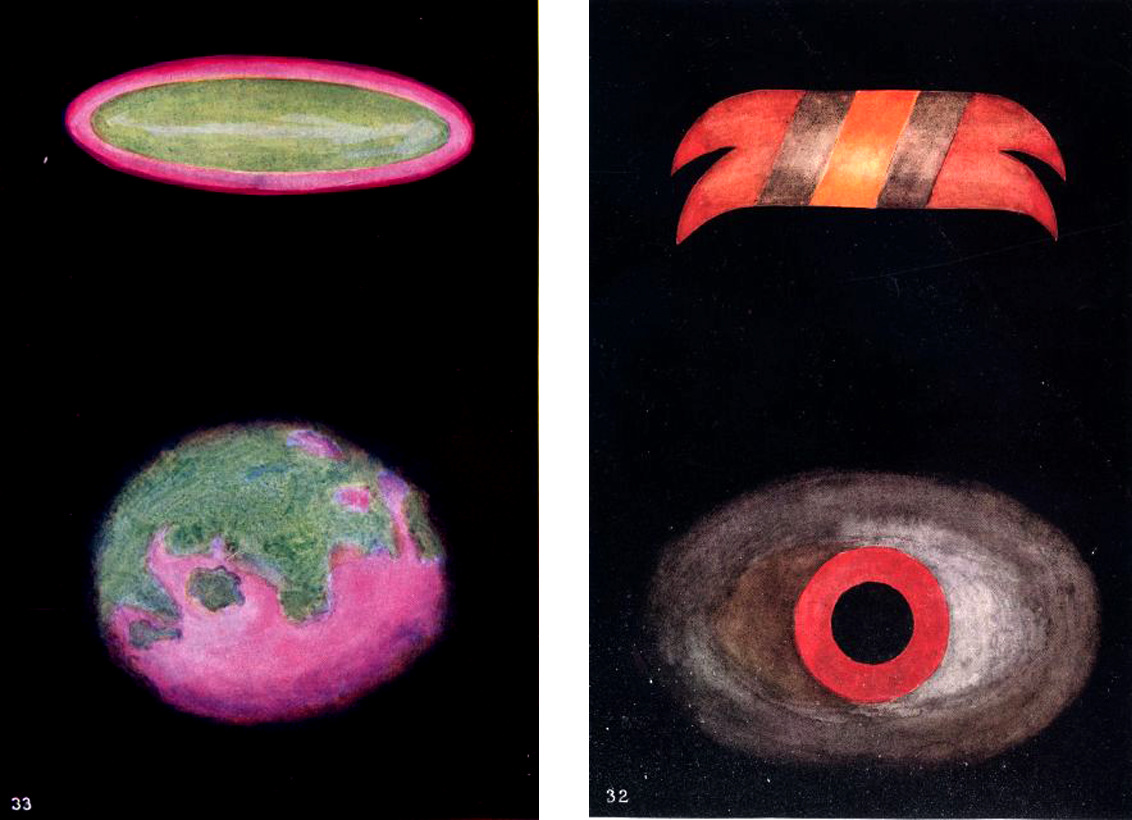


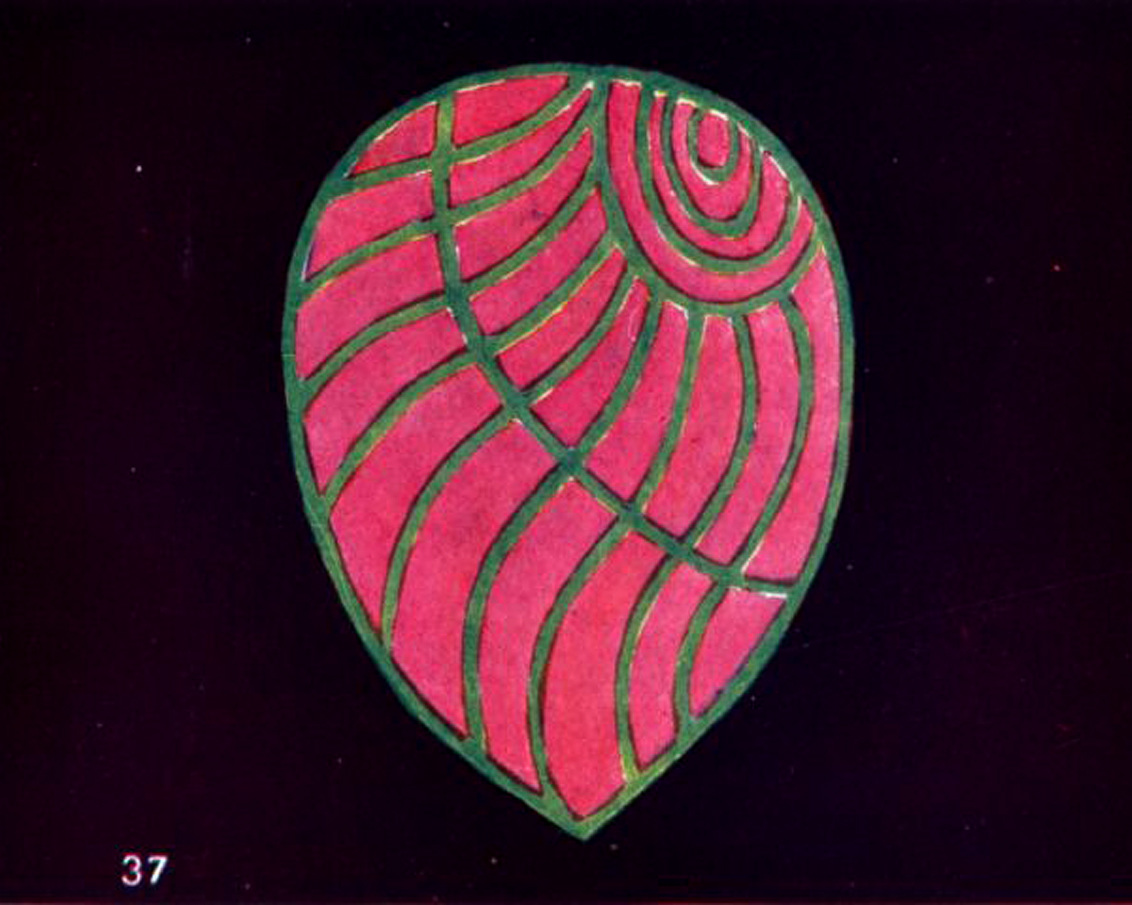
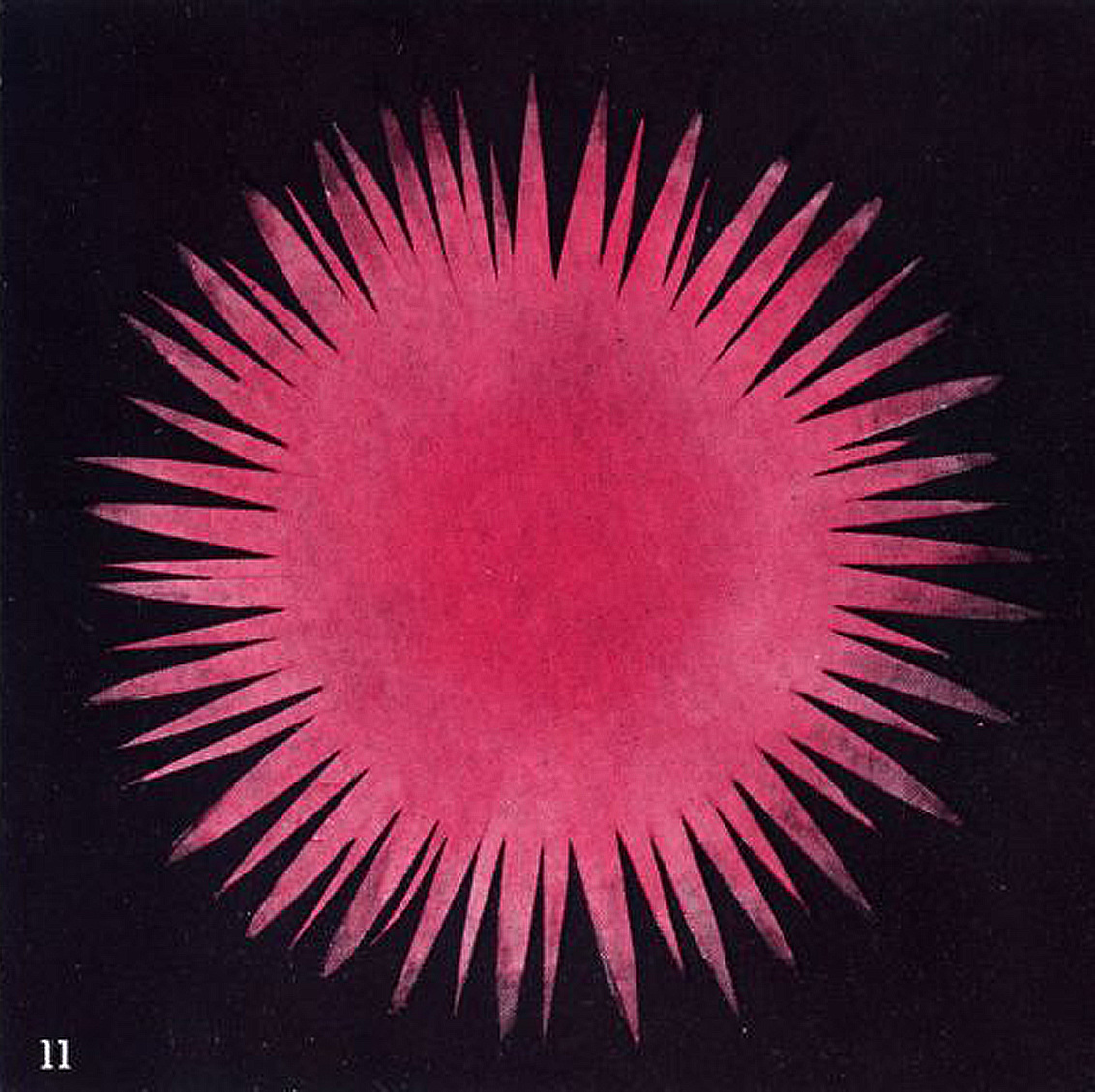
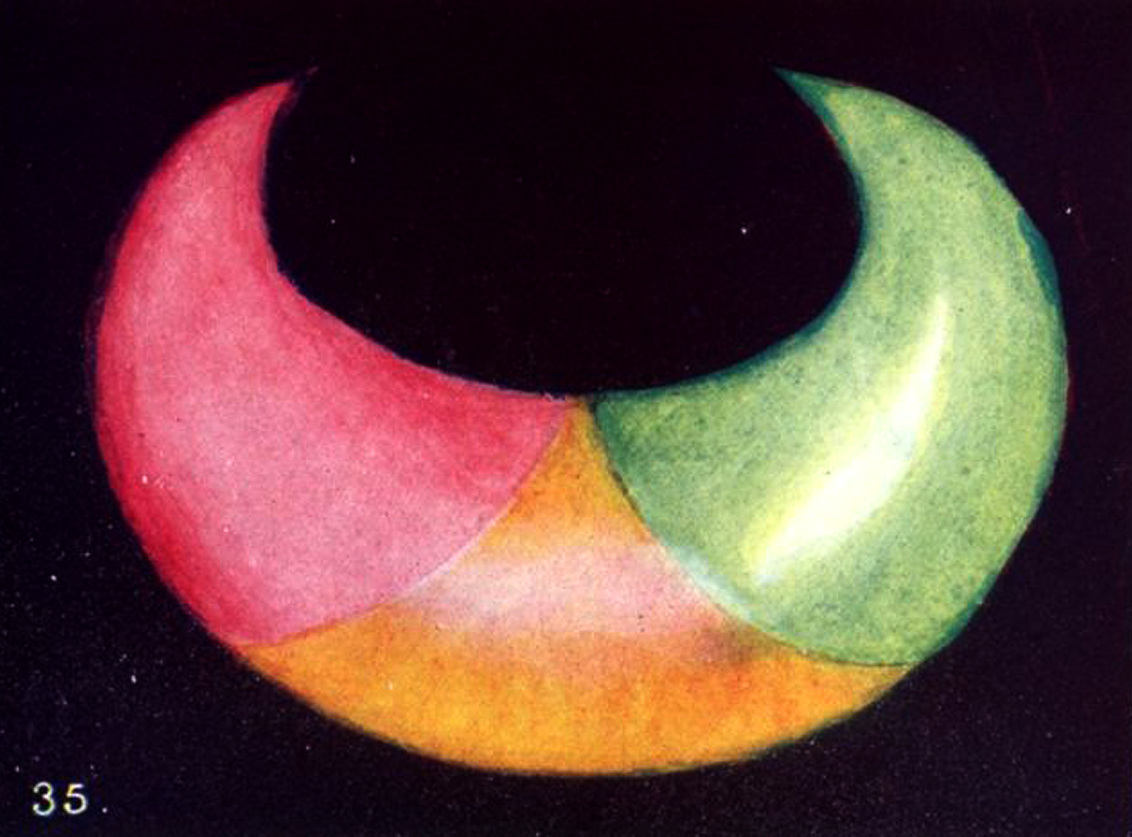
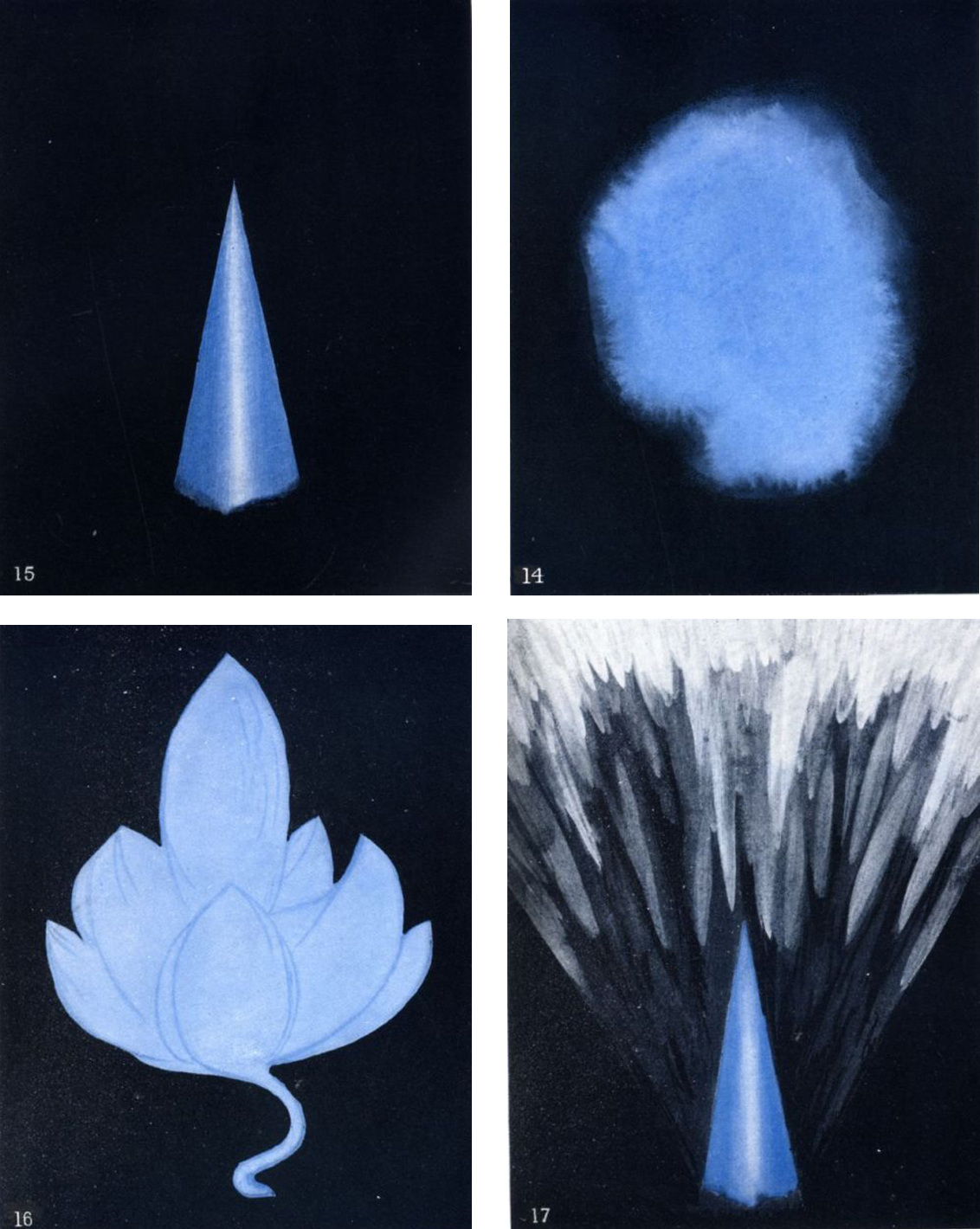
After the publication of ‘Thought-forms’ in collaboration with Leadbeater, the pair produced another book entitled ‘Occult Science: Investigations by Clairvoyant Magnification into the Structure of the Atoms of the Periodic Table’ (1908).
As a continuation from their visual experimentation with thought-forms, this second book detailed a visual and instructional insight into accessing atomic structures through activation of the third eye. The research was carried out over a period of thirty-eight years, often utilising techniques taken from a sanskrit foundational text in Yogic philosophy - the Pātañjalayogaśāstra, through which the observer would acquire the ability to veiw incredibly small objects by reducing his or her astral body to the atomic scale.
Some accounts testify that the findings of their research included not only descriptions of the inner structure of atoms but also descriptions of several isotopes (elements with atoms containing extra neutrons) before the existence of isotopes were known.
Moving along the lines of earlier works from renouned metaphyisician, practitioner of alternative medicine and pioneer of harmonics and Colour-Therapy, Edwin D. Babbitt, their depiction of the ‘ultimate physical atom’ (named the Anu) shared many similarities with Babbitt’s Atom. Both suggested that the atom is a self structuring system of coiled energies, born from polarising forces that express themselves in a characteristic heart-shaped energy field.
For Babbitt, the atom was based on the electro-magnetic principles of polarity in the form of the spiral. Itself the most beautiful of continuous forms, the great leading law of motion in nature. Let us presume, wrote Babbitt, that the spiral direction rules in atoms as well as in worlds... the spiral is a necessity to cover the atom’s whole form and then to convey its force to the next atom. Clad with spiral lines of force, or rather, a spiral framework over which this force vibrates and flows.
As a continuation from their visual experimentation with thought-forms, this second book detailed a visual and instructional insight into accessing atomic structures through activation of the third eye. The research was carried out over a period of thirty-eight years, often utilising techniques taken from a sanskrit foundational text in Yogic philosophy - the Pātañjalayogaśāstra, through which the observer would acquire the ability to veiw incredibly small objects by reducing his or her astral body to the atomic scale.
Some accounts testify that the findings of their research included not only descriptions of the inner structure of atoms but also descriptions of several isotopes (elements with atoms containing extra neutrons) before the existence of isotopes were known.
Moving along the lines of earlier works from renouned metaphyisician, practitioner of alternative medicine and pioneer of harmonics and Colour-Therapy, Edwin D. Babbitt, their depiction of the ‘ultimate physical atom’ (named the Anu) shared many similarities with Babbitt’s Atom. Both suggested that the atom is a self structuring system of coiled energies, born from polarising forces that express themselves in a characteristic heart-shaped energy field.
For Babbitt, the atom was based on the electro-magnetic principles of polarity in the form of the spiral. Itself the most beautiful of continuous forms, the great leading law of motion in nature. Let us presume, wrote Babbitt, that the spiral direction rules in atoms as well as in worlds... the spiral is a necessity to cover the atom’s whole form and then to convey its force to the next atom. Clad with spiral lines of force, or rather, a spiral framework over which this force vibrates and flows.

︎Babbit’s Atom - Edwin D. Babbitt, 1878.


In ‘Occult Chemistry’, the Anu is the basis of all physical structures and many millions of them make up one atom. It is a concept that can be considered analogous to modern day quantum theories of vacuum energy, dark matter and black hole atoms, that bind the universe together through an apparently empty medium or energy field, known in antiquity as ether, and to some theoretical physicists as the mysterious origin of gravity that give objects their mass.
While the idea of a gravitational atom may sound fringe, the principles underlying such a state where described in the 1960’s by physicist Roger Penrose, wherein he showed that energy and angular momentum can be extracted from the surrounding region of a black hole. Before Penrose, in the 1950’s, physicist John Archibald Wheeler formulated a description of gravitational-electromagnetic objects known as Geons, wherein electromagnetic energy can become so high that it curves back on itself due to gravitational interaction, forming a torus-shaped black hole, and will actually appear nearly identical to an elementary subatomic particle (what Wheeler defined as a ‘mass without mass’) and what modern quantum physics describes as an electro-magnetic oscillation of the quantum vacuum.
In the same way, we may regard the Theosophist’s Anu as a fundamental unit of which all material atoms on any plane currently known are composed of. These units are all alike, spherical and absolutely simple in construction. Though they are the basis of all matter, they are not themselves matter.
They could be thought more like bubbles that we see rising in water, bubbles which may be said to have only one surface - namely that of the water which is pushed back by the contained air (just as the bubbles are not water, but are precisely the pockets from which water is absent). So these bubbles are not in fact empty (or ‘koilon’ - the theosophical word of greek origin for ‘emptiness’/‘heaven’), but contain the absence of emptiness.
Yet the interior of these space-bubbles is an absolute void to the highest power of vision.
Much in the same way the atom sized black holes cancel out their observable electircal effects to remain unseen by the naked eye.
The Anu takes it’s name from the ancient Jain cosmological term for ‘the ultimate particle’ - the Paramanu, from which Pudgala (matter) is made. In Jainist texts about the structure of the universe (Mahapurana), matter is derived from the words 'pud', which is defined as Supplementation (Addition /Fusion), and ‘gala’, which is defined as disintegration (Division or Fission). Therefore, Pudgalas are best defined as all things that are continuously changing by the process of Supplementation or Disintegration.
Of the Anu, Besant wrote “In these three whorls flow currents of different electricities: the seven whorls vibrate in response to etheric waves of all kinds - to sound, light, heat, etc. They show the seven colours of the spectrum, give out the seven sounds of the natural scale, respond in a variety of ways to physical vibration - flashing, singing, pulsating bodies, they move incessantly, inconceivably beautiful and brilliant. The Anu is a sun in miniature in its own universe of the inconceivably minute. Each of the seven whorls is connected with one of the Planetary logos so that each has a direct influence on the matter of which all things are constructed.”
What then is their real content - this tremendous force that can blow bubbles in a material of infinite density? These infinitesimal bubbles are the holes in which the life-force digs and tunnels into space and holds things in existence against the pressure of emptiness.
“One of the most interesting of the highroads from the physical to the astral is that of the study of thought. The Western scientist, commencing in the anatomy and physiology of the brain, endeavours to make these the basis for ‘a sound psychology.’ He passes then into the region of dreams, illusions, hallucinations; and as soon as he endeavours to elaborate an experimental science which shall classify and arrange these, he inevitably plunges into the astral plane.“ - Besant.
While the idea of a gravitational atom may sound fringe, the principles underlying such a state where described in the 1960’s by physicist Roger Penrose, wherein he showed that energy and angular momentum can be extracted from the surrounding region of a black hole. Before Penrose, in the 1950’s, physicist John Archibald Wheeler formulated a description of gravitational-electromagnetic objects known as Geons, wherein electromagnetic energy can become so high that it curves back on itself due to gravitational interaction, forming a torus-shaped black hole, and will actually appear nearly identical to an elementary subatomic particle (what Wheeler defined as a ‘mass without mass’) and what modern quantum physics describes as an electro-magnetic oscillation of the quantum vacuum.
In the same way, we may regard the Theosophist’s Anu as a fundamental unit of which all material atoms on any plane currently known are composed of. These units are all alike, spherical and absolutely simple in construction. Though they are the basis of all matter, they are not themselves matter.
They could be thought more like bubbles that we see rising in water, bubbles which may be said to have only one surface - namely that of the water which is pushed back by the contained air (just as the bubbles are not water, but are precisely the pockets from which water is absent). So these bubbles are not in fact empty (or ‘koilon’ - the theosophical word of greek origin for ‘emptiness’/‘heaven’), but contain the absence of emptiness.
Yet the interior of these space-bubbles is an absolute void to the highest power of vision.
Much in the same way the atom sized black holes cancel out their observable electircal effects to remain unseen by the naked eye.
The Anu takes it’s name from the ancient Jain cosmological term for ‘the ultimate particle’ - the Paramanu, from which Pudgala (matter) is made. In Jainist texts about the structure of the universe (Mahapurana), matter is derived from the words 'pud', which is defined as Supplementation (Addition /Fusion), and ‘gala’, which is defined as disintegration (Division or Fission). Therefore, Pudgalas are best defined as all things that are continuously changing by the process of Supplementation or Disintegration.
Of the Anu, Besant wrote “In these three whorls flow currents of different electricities: the seven whorls vibrate in response to etheric waves of all kinds - to sound, light, heat, etc. They show the seven colours of the spectrum, give out the seven sounds of the natural scale, respond in a variety of ways to physical vibration - flashing, singing, pulsating bodies, they move incessantly, inconceivably beautiful and brilliant. The Anu is a sun in miniature in its own universe of the inconceivably minute. Each of the seven whorls is connected with one of the Planetary logos so that each has a direct influence on the matter of which all things are constructed.”
What then is their real content - this tremendous force that can blow bubbles in a material of infinite density? These infinitesimal bubbles are the holes in which the life-force digs and tunnels into space and holds things in existence against the pressure of emptiness.
“One of the most interesting of the highroads from the physical to the astral is that of the study of thought. The Western scientist, commencing in the anatomy and physiology of the brain, endeavours to make these the basis for ‘a sound psychology.’ He passes then into the region of dreams, illusions, hallucinations; and as soon as he endeavours to elaborate an experimental science which shall classify and arrange these, he inevitably plunges into the astral plane.“ - Besant.


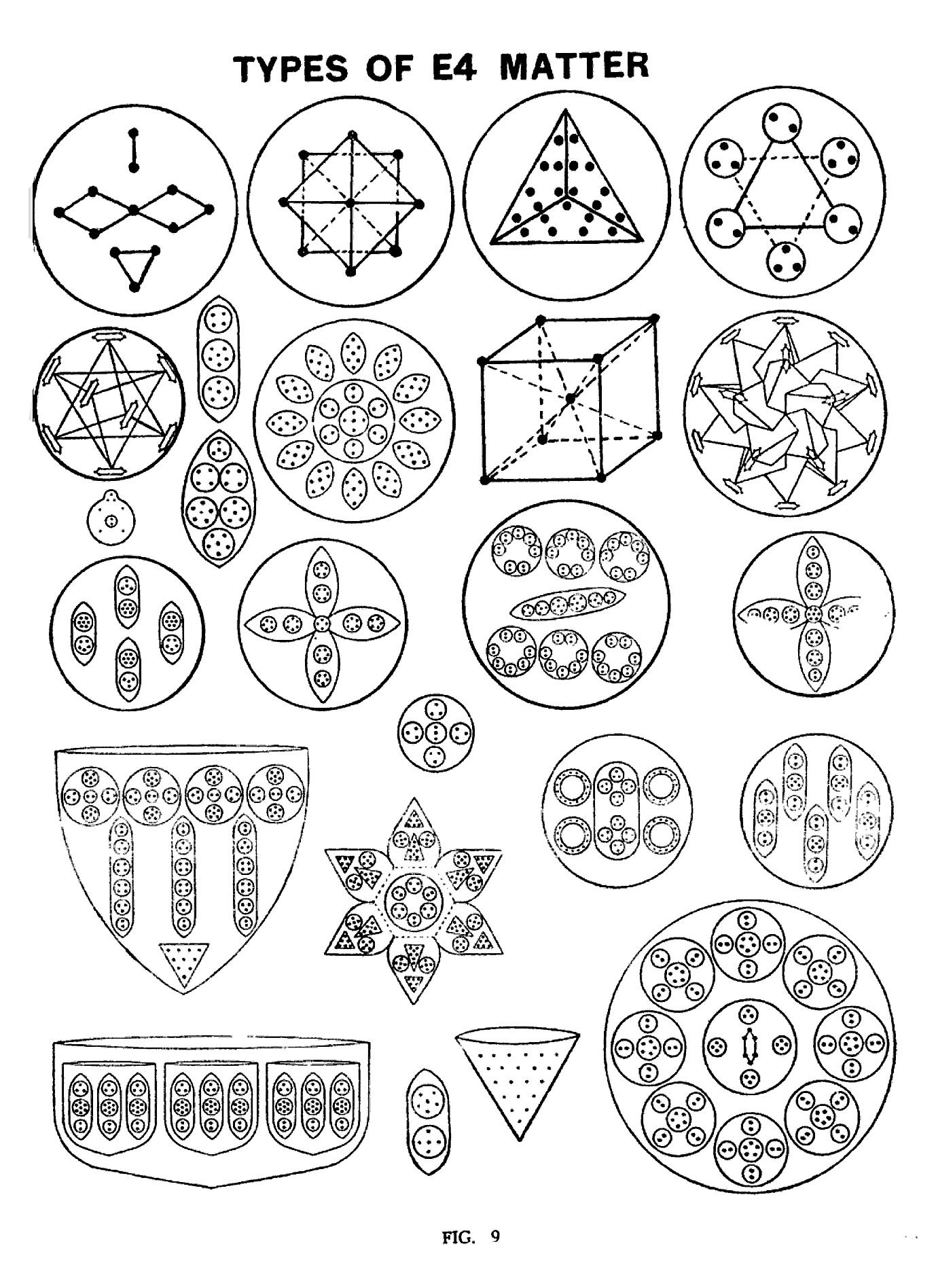



Further Reading ︎
Occult Chemisty, Theosophical Society
Occult Chenistry, book preview
Thought Forms & their meanings
ANNIE BESANT & C.W. LEADBEATER
Black Hole Atoms
Annie Besant, Documentary by Don Cupitt (Part 1)
Don Cupitt, Full Documentary on Multi Culturalism